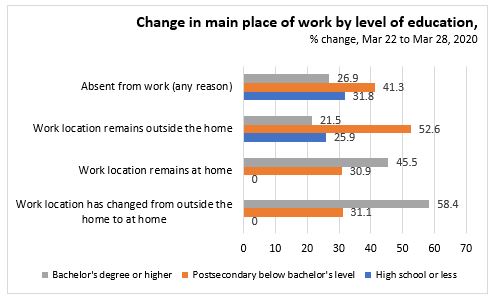The Economics and Statistics Division maintains archives of previous publications for accountability purposes, but makes no updates to keep these documents current with the latest data revisions from Statistics Canada. As a result, information in older documents may not be accurate. Please exercise caution when referring to older documents. For the latest information and historical data, please contact the individual listed to the right.
<--- Return to Archive
For additional information relating to this article, please contact:
April 17, 2020STUDY: CANADIAN PERSPECTIVES SURVEY SERIES 1: IMPACTS OF COVID-19 AND WORKING FROM HOME,2020 Statistics Canada has implemented a new Canadian Perspectives Survey Series (CPSS) based on a web panel survey of 4,600 people in 10 provinces. The CPSS is probabilistic panel based on Labour Force Survey and thus is representative on the general population aged 15 and over. The survey was over the March 29 to April 3 period. This release looks at change in work location related to the COVID-19 crisis.
The effect of COVID-19 on the Canadian labour market continued to deepen after the March LFS was conducted. During the week of March 22 to 28, approximately 4.7 million Canadians worked from home who do not usually work from home. When those who usually work from home are included, 4 in 10 workers (39.1% or 6.8 million) worked from home during the week of March 22. About the same number (38.5% or 6.7 million) worked at locations other than home. In addition, approximately 2 in 10 workers (22.4% or 3.9 million) were absent from their jobs, with 2.8 million of them being absent for reasons related to COVID-19.
An important finding of the March LFS was that employment declines were greatest in occupations related to sales and services which require face-to-face interactions or where working from home is not practical. Employment was little changed in several broad occupational categories for which previous Statistics Canada data suggest telework is more feasible, including management, natural and applied sciences, and business, finance and administration.
The CPSS results suggest that those who do not normally work from home but did so during the week of March 22 were much more likely to have a bachelor's degree or higher (58.4%) than those who had continued to work outside the home (21.5%) and those who were absent from work (26.9%). This provides further evidence that working from home is more feasible for workers employed in professional or managerial occupations, which typically require higher levels of education.

The Canadians who reported that they did not normally work from home but did so during the week of March 22, about 4 in 10 (39.6%) live with a child under the age of 18, and experienced new challenges in balancing work and family life.
They were just as likely to report having good, very good or excellent mental health as those who usually work from home and those who continued to work at locations other than home. There was also little difference between these groups in terms of the level of concern with family stress from confinement.
Statistics Canada: Canadian Perspectives Survey Series 1: COVID-19 and working from home, 2020
<--- Return to Archive